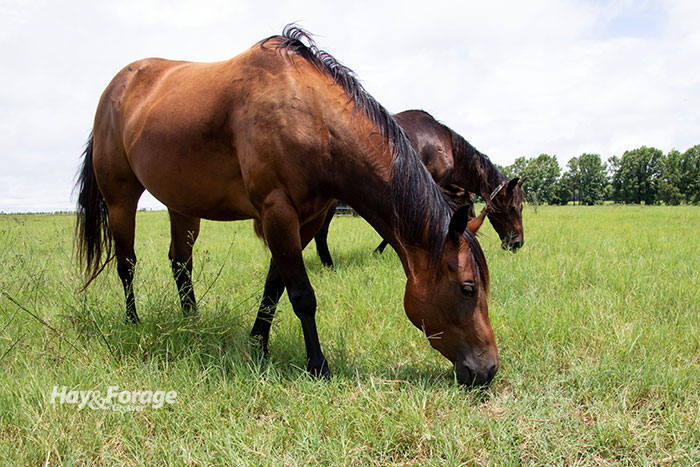
Despite a few species-specific differences, horse owners can follow many of the same grazing practices cattle producers adhere to during drought. Doing so will limit damage to perennial forage stands and help maintain animal performance through periods of dry weather.
One distinction between grazing horses and cattle is the impact nonstructural carbohydrate (NSC) content of forage has on animal health. Krishona Martinson with the University of Minnesota explains cool-season grasses normally contain 12% to 16% NSC, but this number can exceed 20% during drought.
“Grasses tend to accumulate NSC to help buffer the negative impacts of stress, including drought,” the equine specialist states. “While elevated NSC concentrations may not negatively affect healthy horses, these levels are likely to cause issues in horses with a history of laminitis, obesity, equine metabolic syndrome, and other diagnoses requiring a diet lower in NSC.”
High nitrate levels in drought-stressed forage also have potential to harm both horses and cattle. The former group of livestock should not consume forage with a nitrate concentration above 4,600 ppm, which is most likely to occur in weedy pastures, warm-season grasses, and early forage regrowth.
In addition to these risks, Martinson advises horse owners to be mindful of grazing management. Her primary tips are to avoid overgrazing, control weeds, boost soil fertility, and feed horses hay when necessary.
Avoid overgrazing. A lack of moisture combined with hot temperatures discourages plant growth and can cause cool-season species to go dormant in the summer. Remove horses from a field before animals graze grass below 3 inches tall. Then, wait until forage is 6 to 8 inches tall before allowing horses access to this part of the pasture again.
Adjusting stocking density can further prevent overgrazing. Lower the number of horses on pasture at a time and/or shorten grazing periods to alleviate grazing pressure. Martinson also recommends using grazing muzzles to curb animals’ forage intake by up to 30%.
Control weeds. “Some weeds are especially good at surviving in dry conditions and use scarce water resources,” Martinson notes. Minimize weed competition by applying herbicides that are intended for pasture use and compatible with current environmental conditions. Martinson also reminds farmers to follow grazing restrictions found on product labels.
Improve soil fertility. Consider using fertilizer to boost soil fertility in drought-stressed forage stands. Take a soil sample to identify deficient nutrients and determine appropriate application rates. The ideal time to apply fertilizer — especially nitrogen fertilizer — is prior to a rainfall event.
Feed hay in a dry lot. Relocating horses to a dry lot and feeding them hay until forage growth returns to normal can help safeguard root systems and stand longevity. With that said, horses must be reacclimated to fresh grass after consuming hay for an extended period to prevent digestive issues or colic due to the change in their diet.
If animals spend less than two weeks in a dry lot, Martinson recommends reintroducing them to the pasture in 30-minute increments every day. For example, let animals graze for 30 minutes the first day, 60 minutes the second day, 90 minutes the third day, and so on. These horses can regain unrestricted access to the pasture once they have reached five hours of grazing time, or after 10 days.
Horses that spend more than two weeks off pasture require a slower approach to acclimation. In this case, reduce daily grazing increments to 15 minutes per day until animals reach five hours of grazing to ensure their gut microbiome has adequate time to adjust to the different feedstuffs.

